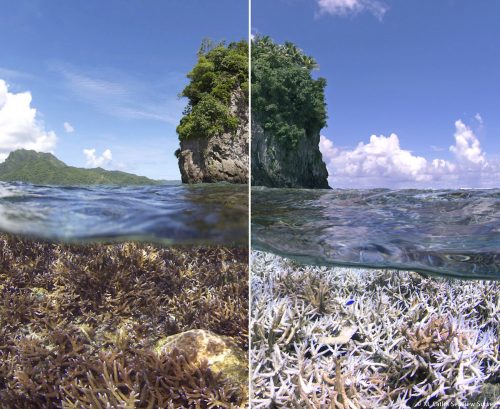A pristine bed of corals shimmers pure white, surrounded by silence. Water calmly brushes over these stagnant structures, with no other life in sight. This seemingly beautiful scene is quite deceiving, as it depicts a coral graveyard after a mass bleaching event. The vivid, vibrant colors of ordinary corals have been usurped by a sickening white, and entire schools of fish that once relied on the coral have disappeared. Over just a two-month period, an entire coral reef ecosystem has been destroyed.
The culprit? An increase in the average ocean temperature by two degrees Celsius. While two degrees seems minimal, even slight increases in ocean can wipe out entire reefs. Heat waves cause coral to eject their main food source, symbiotic algae, and lose their vivid colorations. Thus, begins the first stage of death for the coral: coral bleaching.
Jeff Orlowski, director of the award-winning documentary “Chasing Ice,” recently released a follow-up documentary called “Chasing Coral,” which focuses on a lesser-known danger of climate change: coral bleaching. The film follows a team of divers who endeavor to bring the realities of climate change and coral bleaching to the public. Viewers follow the divers as they continue the daily struggle of watching beautiful fields of coral slowly wither away.
The film truly excels at the art of “show, don’t tell.” Shocking facts are coupled immediately with haunting imagery. Salient side-by-side comparisons of coral before and after bleaching in the documentary illustrate how the bustling, lively nature of coral reefs is destroyed by bleaching, leaving only foreign algae to drape the skeletal remains of the coral. “Chasing Coral” also masterfully illustrates the emotional impact coral bleaching can have on people, which is particularly apparent when the divers are visibly shaken by the destruction they photograph daily.
In its middle, the film’s pacing becomes somewhat sluggish. It often focuses too deeply on the methodology of capturing images of coral, instead of analyzing the process of bleaching or the methods through which corals support ecosystems. The documentary also jumps between the perspectives of multiple people too quickly at times, which can detract from the significant experiences of each person.
Still, the climax and ending masterfully cinch the documentary together by reassuring viewers of the many ways we can contribute in the fight against climate change. The film’s seamless combination of informative commentary and engaging storytelling make “Chasing Coral” not only an entertaining watch, but a necessary one to understand the full threat climate change already poses to our environment.

